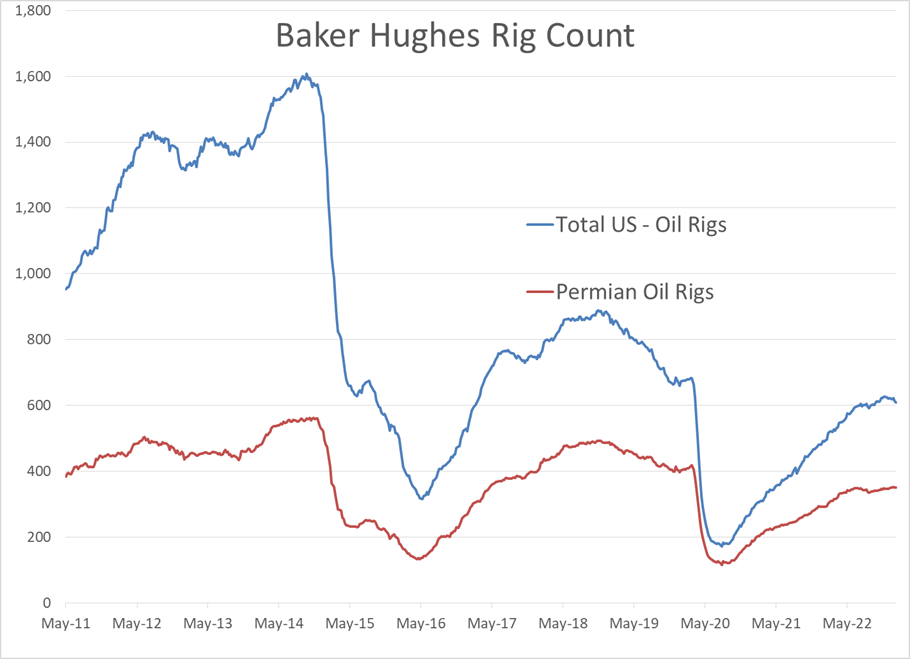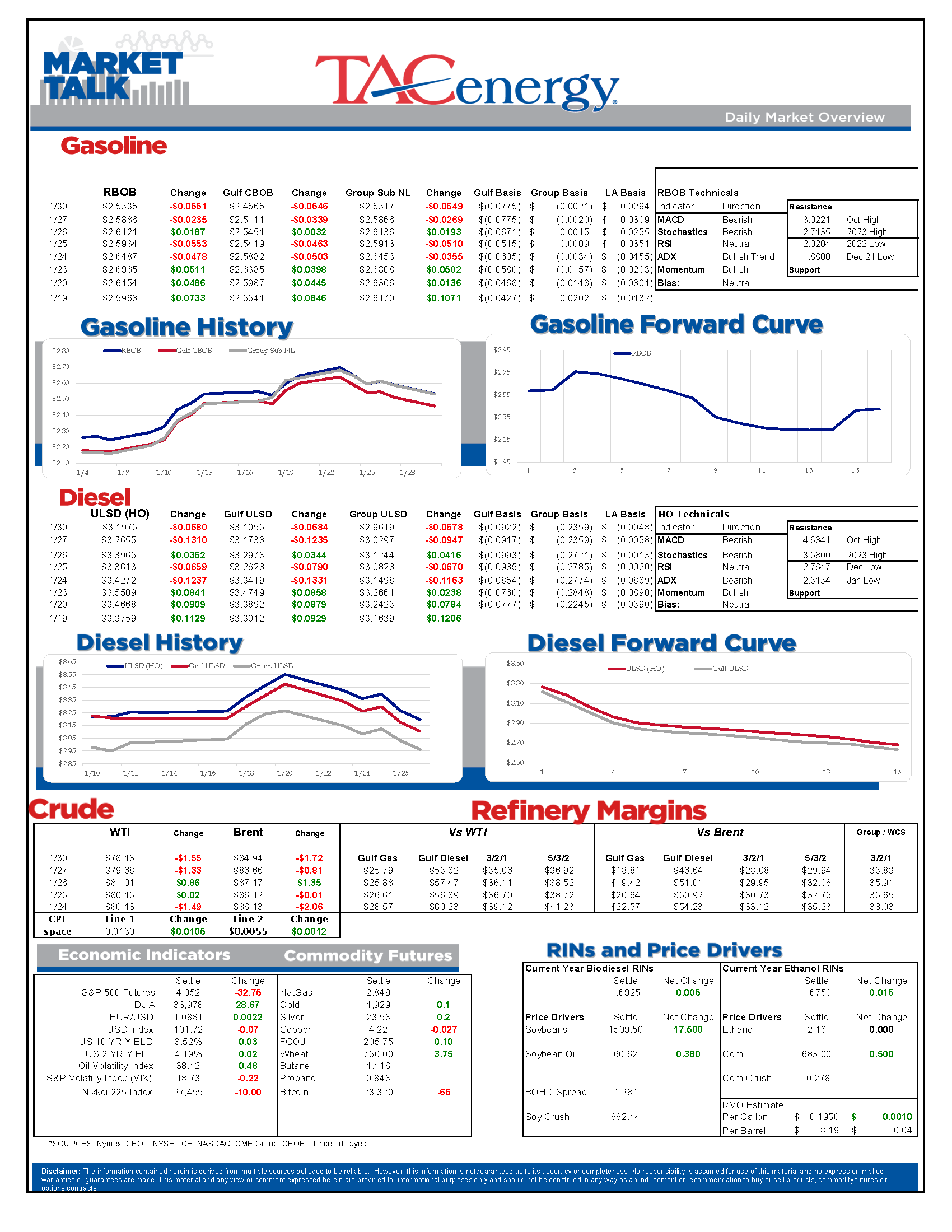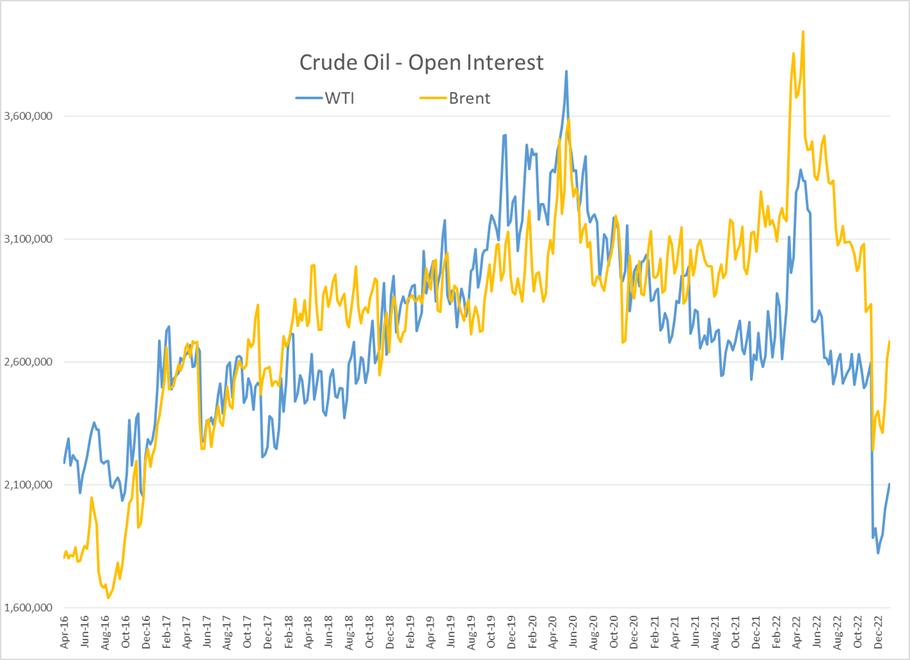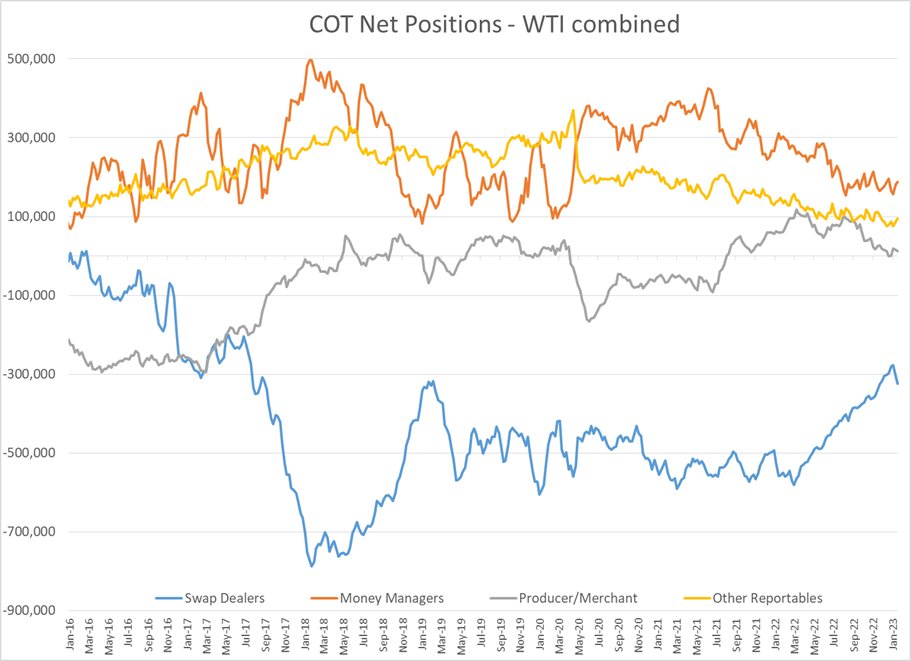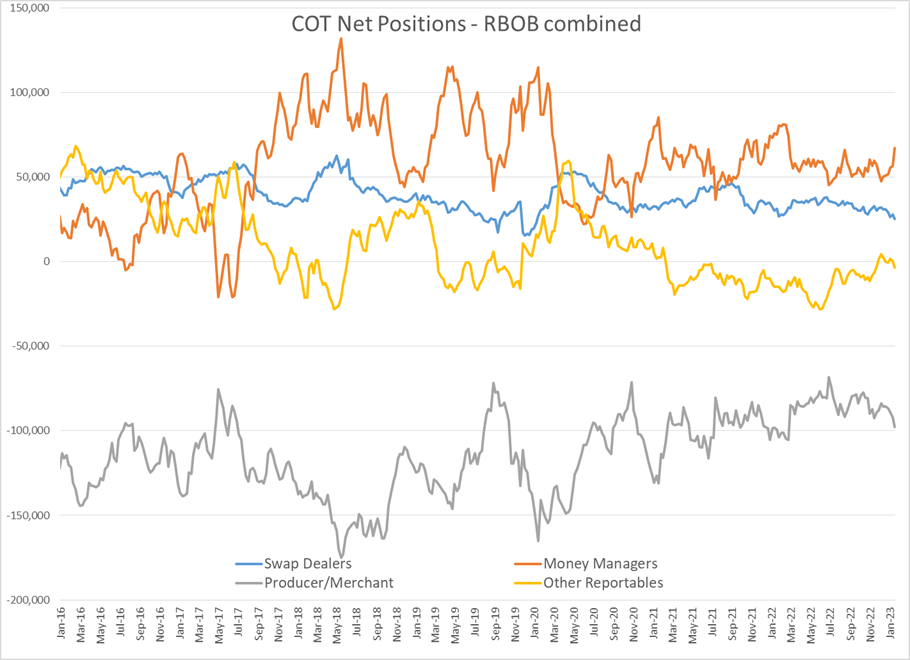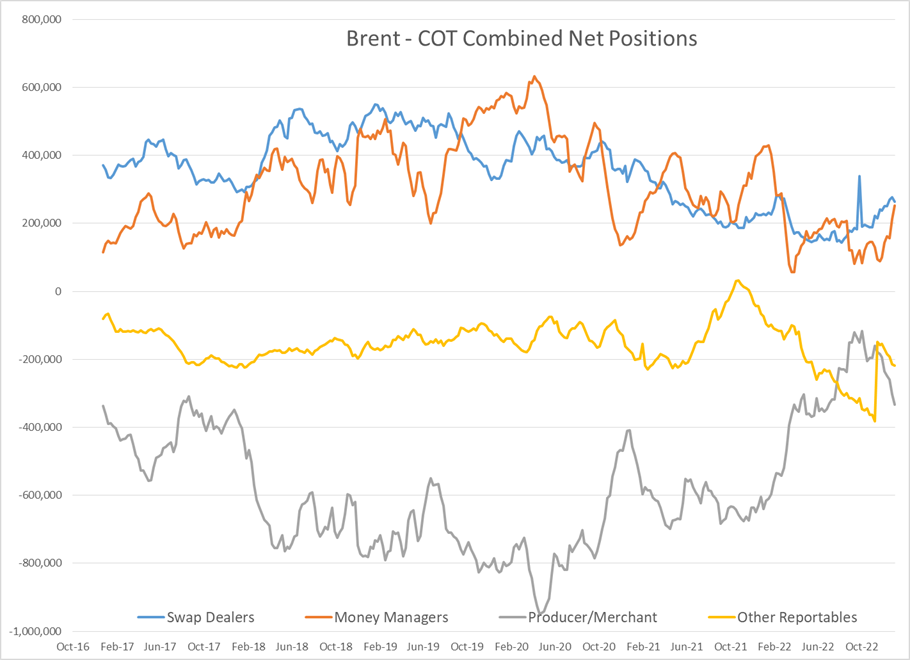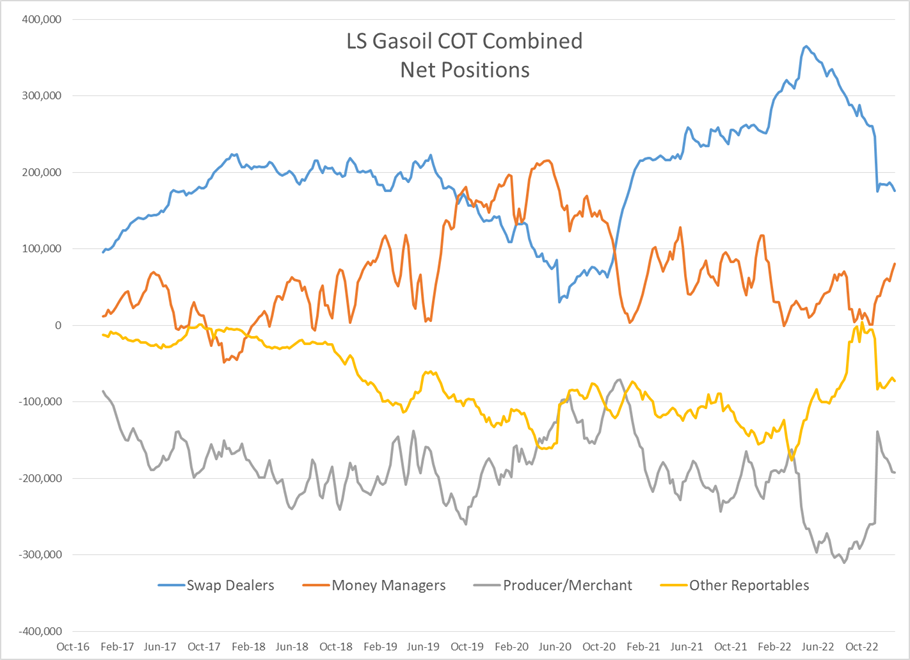Energy Futures Tumbling Again to Speculator's Chagrin

Diesel futures are leading the energy complex lower for a 2nd straight day and have dropped 24 cents from Friday’s highs. In total, ULSD futures are down 39 cents from the highs set last Tuesday, and the bulls are now in rally-or-else territory as the 6-week-old trend line is suddenly under pressure. The moves for RBOB have been less dramatic, with gasoline prices “only” dropping 11 cents since Friday morning’s highs, which leaves more room to fall before gasoline threatens its weekly trend-lines.
The big selloff looks like it will have several hedge funds wishing for a do-over after adding to their bets on higher fuel prices last week. The big 5 NYMEX and ICE contracts all saw healthy increases in long positions held by money managers in the latest report from the CFTC, while Brent, WTI and ULSD contracts also saw heavy short covering, just before those bets on lower prices would have paid off.
Open interest in crude and refined product contracts saw another week of healthy increases, making it appear that the recent reduction in volatility has more traders getting comfortable returning to the petroleum space after many bailed out during the chaotic trading in 2022.
The timing of this latest pullback in diesel prices is particularly curious given that we’re now less than a week away from the highly anticipated embargos on Russian distillates taking effect. European imports of Russian diesel have surged in recent weeks to get supplies in before the restrictions take place, which may be causing some short-term excess supply, although longer term there are still major concerns about distillate supplies globally.
There’s another winter storm warning issued to oil and gas pipeline operators in Texas this week, but the freezing temperatures aren’t expected to extend south into the refinery zone along the Gulf Coast, so we should not see a widespread impact from this system like we did in December.
A study published by the Environmental Integrity Project is getting a fair amount of press as it highlights the water pollution caused by US oil refineries and the failure of the EPA to enforce the Clean Water Act. The study could end up being a catalyst that forces the EPA to update its 40-year-old standards for wastewater disposal or may be ignored if higher fuel prices become a bigger news story again this year.
Baker Hughes reported a drop of 4 oil rigs drilling in the US last week, offset for a 2nd straight week by an increase in natural gas drilling rigs. Notable this week was that the decline in oil drilling was almost all in waters off the Louisiana coast, while the Permian basin saw a net increase of 3 rigs.
Click here to download a PDF of today's TACenergy Market Talk.
News & Views
View All
Energy Futures Are Caught Up In Headline Tug-O-War This Morning
Energy futures are caught up in headline tug-o-war this morning with Canadian oil production concerns and a positive US GDP report trying to push prices higher while sinking Chinese demand worries and Gaza ceasefire hopes are applying downward pressure. The latter two seem to be favored more so far this morning with WTI and Brent crude oil futures down ~45 cents per barrel, while gasoline and diesel prices are down about half a cent and two cents, respectively.
No news is good news? Chicago gasoline prices dropped nearly 30 cents yesterday, despite there not being any update on Exxon’s Joliet refinery after further damage was discovered Wednesday. Its tough to say if traders have realized the supply situation isn’t as bad as originally thought or if this historically volatile market is just being itself (aka ‘Chicago being Chicago’).
The rain isn’t letting up along the Texas Gulf Coast today and is forecasted to carry on through the weekend. While much of the greater Houston area is under flood watch, only two refineries are within the (more serious) flood warning area: Marathon’s Galveston Bay and Valero’s Texas City refineries. However, notification that more work is needed at Phillip’s 66 Borger refinery (up in the panhandle) is the only filing we’ve seen come through the TECQ, so far.
Premiums over the tariff on Colonial’s Line 1 (aka linespace value) returned to zero yesterday, and actually traded in the negatives, after its extended run of positive values atypical of this time of year. Line 1’s counterpart, Line 2, which carries distillates from Houston to Greensboro NC, has traded at a discount so far this year, due to the healthy, if not over-, supply of diesel along the eastern seaboard.
Click here to download a PDF of today's TACenergy Market Talk.

WTI And Brent Crude Oil Futures Are Trading ~$1.50 Per Barrel Lower In Pre-Market Trading
The across-the-board drawdown in national energy stockpiles, as reported by the Department of Energy yesterday, stoked bullish sentiment Wednesday and prompt month gasoline, diesel, and crude oil futures published gains on the day. Those gains are being given back this morning.
The surprise rate cut by the People’s Bank of China is being blamed for the selling we are seeing in energy markets this morning. While the interest rate drop in both short- and medium-term loans won’t likely affect energy prices outright, the concern lies in the overall economic health of the world’s second largest economy and crude oil consumer. Prompt month WTI and Brent crude oil futures are trading ~$1.50 per barrel lower in pre-market trading, gasoline and diesel are following suit, shaving off .0400-.0450 per gallon.
Chicagoland RBOB has maintained its 60-cent premium over New York prices through this morning and shows no sign of coming down any time soon. Quite the opposite in fact: the storm damage, which knocked Exxon Mobil’s Joliet refinery offline on 7/15, seems to be more extensive than initially thought, potentially extending the repair time and pushing back the expected return date.
There are three main refineries that feed the Chicago market, the impact from one of them shutting down abruptly can be seen in the charts derived from aforementioned data published by the DOE. Refinery throughput in PADD 2 dropped 183,000 barrels per day, driving gasoline stockpiles in the area down to a new 5-year seasonal low.
While it seems all is quiet on the Atlantic front (for now), America’s Refineryland is forecasted to receive non-stop rain and thunderstorms for the next four days. While it may not be as dramatic as a hurricane, flooding and power outages can shut down refineries, and cities for that matter, all the same, as we learned from Beryl.

